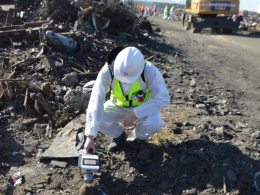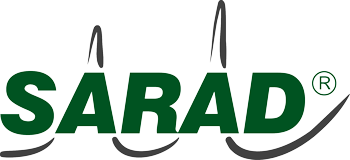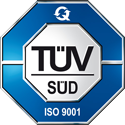Detection of sources during illegal transportation and disposal
Smuggling of radioactive materials for terrorist purposes represents a today-scenario to be taken very seriously. Therefore, potential routes of transportation (airports, borders) and the access to critical infrastructure will be checked.
A similar scenario is with waste disposal enterprises where incoming waste materials must be checked for radiation sources that will be delivered illegally or due to ignorance.
Detection can only be performed by means of the gamma radiation emission because it can penetrate the material and enclosure. A priori, neither the source position nor its activity and nuclide composition are known.
Thus two issues will arise:
- By the distance rule, the intensity of the radiation will heavily decrease with the distance from the source. The intensity can also be diminished by appropriate transportation containers.
- The sources have to be evaluated concerning their nuclide composition. It should be identified whether the activity measured will be caused by the natural uranium/thorium content of the transported materials to be disposed or be caused by a hidden source in there.
It depends on the counting efficiency and on the spectroscopic resolution of the detector whether a source of radiation with a specific strength, within a specific distance to the measuring instrument can be detected within a specific period of time. The counting efficiency is mainly determined by the size of the detector and by its material. The latter defines the spectroscopic properties of the detector as well.
For portable measuring instruments, nearly always scintillation detectors are used, since they:
- are very robust,
- have sufficient spectroscopic capability,
- can be operated at normal temperatures,
- have a high material-specific counting efficiency,
- are available as large crystals.
NaI(TI) detectors offer an optimum regarding spectroscopic resolution, size of the crystal and price.
In order to be able to trace radioactive sources in various places, hand-held instruments are suited best. This sets an upper limit for the size of the detector. 2″×2″ crystals are handy and offer a high counting efficiency already. Larger crystals (e.g. 3″×3″) weight already so much, that an all-day long work would require a high physical effort.
When searching illegally carried radioactive sources it is undesired that the owner of the scanned luggage or the inspecting person will be warned by an alarm or a glance on the display. Therefore the instrument should have a wireless connection with a control room where the personnel can decide about the further procedure.
The SARAD Nuc Scout with its 2″×2″ NaI(Tl) detector (3″ available as option) offers a high counting efficiency at moderate weight and price. The integrated spectroscopy verifies up to 28 isotopes that can be defined in four libraries (natural, medical, industrial, sources).
The Nuc Scout is ready to work instantly right after switch-on. It requires no manipulation during operation. The integrated battery lasts a complete shift long (typically 16 hours). The large display is legible even in the direct sunlight and can be switched off. The integrated wireless interface according to the ZigBee standard allows the communication with a control room over a distance of up to 100 meter. The required monitoring software is already included in the scope of delivery. For preservation of evidence, all measuring data is stored on the instrument with time and position.



